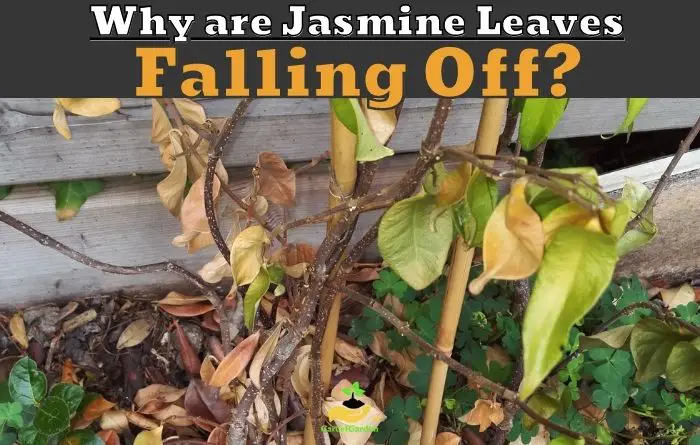Why Are Your Jasmine Leaves Falling Off? (Easy Answer)
Jasmine is a hardy plant known for its beautiful blooms and aromatic fragrance. However, sometimes we notice with surprise that our jasmine leaves start falling off. Leaf drop in jasmine plants can be caused by various factors, including environmental conditions, pests, diseases, and cultural practices.
Jasmine leaf fall can be a sign of an underlying problem with the plant. The most common causes of jasmine leaf drop include sudden changes in growing conditions, overwatering, underwatering, poor soil conditions, and pest infestations.
Understanding the common causes of leaf fall and implementing preventive measures can help ensure the health and vitality of your jasmine plant.
Common Causes of Jasmine Leaf Fall
It can be disheartening to witness the leaves of your jasmine plant falling off. Several factors contribute to this phenomenon, ranging from environmental conditions to pests and diseases.
In this section, we will delve into the common causes of jasmine leaf fall, exploring each factor in detail and providing effective treatments.
1. Environmental Factors
Environmental factors such as temperature, humidity, and light can impact the health of jasmine leaves.
Extreme temperature fluctuations, excessively hot or cold conditions, and low humidity levels can cause stress to the plant, leading to leaf drop. Inadequate or excessive sunlight exposure can also affect leaf health.
| Environmental Factors | Effect on Jasmine Leaves |
|---|---|
| High temperatures | Prolonged exposure to excessive heat leads to leaf withering and falling off. |
| Cold temperatures | Frost or freezing temperatures can damage leaves, causing browning and drop. |
| Insufficient sunlight | Inadequate sunlight hinders photosynthesis, weakening leaves and leading to fall off. |
| Excessive sunlight | Intense and direct sunlight can scorch leaves, causing damage and eventual drop. |
| High humidity | Excessive humidity can promote fungal diseases, causing leaf damage and premature drop. |
| Low humidity | Insufficient humidity results in excessive moisture loss through transpiration, leading to leaf desiccation and drop. |
https://www.rhs.org.uk/plants/jasmine/growing-guide
Excess sunlight
- Cause: The sun in direct exposure can dry the jasmine if it is not helped by frequent watering, but the sun can also dry it, if it was previously in a cooler place or in semi-shade.
- Solution: Move it around or leave it there and seek some shade, at least for a few hours a day.
High humidity
- Cause: Excess moisture rots the roots. The stem and leaves become weaker, they assume a position in which they are seen leaning downwards which will cause them to droop over the days or, if you touch them, they will easily come off.
- Solution: You can solve it by removing the weak leaves, changing its location to remove the accumulated water and, ultimately, removing it from the ground, removing the roots that you see in a state of rot and replanting it with less humidity.
Treatment
To mitigate the impact of environmental factors, it’s important to provide optimal growing conditions for your jasmine plant. Maintain a consistent temperature range of 60-75°F (15-24°C) and protect the plant from sudden temperature changes.
Ensure your jasmine receives sufficient sunlight without being exposed to direct, intense sunlight for prolonged periods. Regularly mist the leaves to increase humidity levels around the plant.
2. Over or Underwatering

From my experience, improper watering practices can significantly affect jasmine plants by disrupting the plant’s ability to regulate its water balance, which can negatively impact leaf health.
When the soil becomes too dry and then suddenly floods with water, it shocks the roots and can lead to leaf drop.
Fluctuating between periods of overwatering and underwatering can be stressful for jasmine plants.
When jasmine roots get waterlogged, they cannot absorb water and nutrients properly. Overwatering can lead to root rot and fungal diseases, causing the leaves to wilt and drop.
On the other hand, underwatering can cause the leaves to wilt and fall off. When a plant doesn’t get enough water, it cannot carry out essential functions like photosynthesis and nutrient absorption. This can cause the leaves to dry out and fall off.
Treatment
Establish a watering routine for your jasmine plant based on its specific needs. Allow the top inch of soil to dry out before watering again. Ensure proper drainage to prevent waterlogged soil.
I recommend you use a moisture meter to determine when watering is necessary. Adjust the watering frequency depending on seasonal variations and the plant’s growth stage.
| Jasmine Variety | Watering Frequency | Watering Amount |
|---|---|---|
| Common Jasmine (Jasminum officinale) | Once a week | 1-2 inches of water |
| Arabian Jasmine (Jasminum sambac) | Twice a week | 1-2 inches of water |
| Winter Jasmine (Jasminum nudiflorum) | Once a week | 1-2 inches of water |
3. Nutrient Deficiencies
Insufficient or imbalanced nutrient levels can impact the overall health of jasmine plants, leading to leaf drop. Common deficiencies include nitrogen, iron, and magnesium, which can result in the yellowing of leaves and premature shedding.
Here’s how nutrient deficiencies can cause jasmine leaves to fall:
- Lack of Nitrogen: Nitrogen is an important nutrient that helps plants produce chlorophyll, which is essential for photosynthesis. When a jasmine plant lacks nitrogen, its leaves may turn pale or yellowish-green. Over time, the leaves become weak and may start to fall off.
- Insufficient Phosphorus: Phosphorus is necessary for energy transfer and root development. If a jasmine plant doesn’t get enough phosphorus, its leaves may become darker and exhibit purple or reddish discoloration. The plant may also have stunted growth and experience leaf drop.
- Inadequate Potassium: Potassium helps with overall plant health and plays a role in water and nutrient movement within the plant. When a jasmine plant lacks potassium, its leaves may develop yellow or brown spots and exhibit dry or scorched edges. In severe cases, the leaves may wither and fall off.
Treatment
Again, as a recommendation, conduct a soil test to identify any nutrient deficiencies. Provide appropriate fertilizer formulations specifically designed for flowering plants like jasmine.
Incorporate organic matter into the soil to improve its nutrient content. Follow recommended fertilizer application rates and frequency to prevent over-fertilization, which can be equally detrimental to the plant’s health.
4. Pests and Diseases
Jasmine plants can be susceptible to pests such as aphids, spider mites, whiteflies, and diseases like powdery mildew and leaf spot. These infestations can weaken your jasmine, causing leaf drop.
| Pests | Effect on Jasmine Leaves | Treatment Option |
|---|---|---|
| Aphids | Small, soft-bodied insects that feed on plant sap, causing leaf curling, yellowing, and distortion. Severe infestations can lead to leaf drop. | Spray affected leaves with a strong stream of water to dislodge aphids or apply neem oil. |
| Spider Mites | Tiny arachnids that feed on plant sap, causing stippling (tiny yellow spots) on leaves. Severe infestations can result in leaf discoloration and fall off. | Rinse leaves with water to remove mites. Then spray with insecticidal soap or neem oil. |
| Whiteflies | Small, flying insects that cluster on the underside of leaves and suck plant sap. Leaves may turn yellow, become sticky, and drop prematurely. | Use yellow sticky traps to catch adult whiteflies. |
| Scale Insects | Hard or soft scale insects attach themselves to the plant and suck sap, leading to yellowing, leaf wilting, and eventual leaf fall. | Gently scrub scales off leaves with a soft brush or cloth. Prune heavily infested branches. |
https://www.gardeningknowhow.com/ornamental/flowers/jasmine/jasmine-pest-control.htm
| Diseases | Effect on Jasmine Leaves | Treatment Option |
|---|---|---|
| Powdery Mildew | Fungal infection characterized by a white powdery coating on leaves, yellowing and falling leaves. | Remove infected leaves and treat with a fungicide. Apply fungicides containing potassium bicarbonate. |
| Leaf Spot | Fungal or bacterial infections that cause circular or irregular spots on leaves. Severe cases may result in leaf yellowing, browning, and drop. | Remove affected leaves and dispose of them. Apply fungicides or bactericides according to label instructions. |
| Root Rot | Fungal disease that affects the roots, often caused by overwatering or poorly drained soil. Infected roots cannot supply enough nutrients to the leaves, leading to their yellowing and drop. | Improve drainage and avoid overwatering. |
| Bacterial Leaf Blight | Bacterial infection that causes water-soaked lesions on leaves. It can result in leaf discoloration, wilting, and premature leaf drop. | Remove infected leaves and apply copper-based bactericides. |
| Anthracnose | Fungal disease causing dark, sunken lesions on leaves. Severe infections may lead to defoliation and leaves falling off. | Remove infected leaves and apply fungicides containing copper or chlorothalonil. |
Treatment
Regularly inspect your jasmine plant for signs of pests or diseases. Introduce natural predators like ladybugs to control aphid populations.
Use insecticidal soaps or horticultural oils to treat pest infestations.
For fungal diseases, apply appropriate fungicides according to the manufacturer’s instructions. Prune affected plant parts to prevent the spread of diseases.
How to Prevent Jasmine Leaves from Falling Off
Preventing leaf drop in jasmine plants requires proactive measures and proper care. By implementing the tips and strategies I give you, you can create an optimal environment for your jasmine plant, ensuring its foliage remains vibrant and healthy.
Maintain Ideal Growing Conditions
Provide a suitable environment for your jasmine plant by maintaining a consistent temperature, humidity, and light levels. Avoid exposing the plant to extreme temperature fluctuations or prolonged periods of direct sunlight.
Use shade cloth or relocate the plant during intense summer heat. Increase humidity levels by misting the leaves or placing a water tray nearby.
Water Properly
Establish a watering routine based on your jasmine plant’s needs. Water thoroughly, allowing the top inch of soil to dry out before watering again. Ensure good drainage to prevent waterlogging.
Avoid overwatering or underwatering, as both can lead to leaf drop. Consider using self-watering containers or moisture meters to regulate watering.
Provide Nutrient-Rich Soil
Ensure that your jasmine plant has access to nutrient-rich soil. Incorporate organic matter, such as compost or well-rotted manure, into the soil before planting. This helps improve soil fertility and provides essential nutrients for healthy leaf growth.
Additionally, consider using slow-release fertilizers specifically formulated for flowering plants like jasmine. Follow the recommended application rates and schedule to avoid over-fertilization.
Prune and Maintain Proper Hygiene
Regular pruning helps maintain the overall health and shape of your jasmine plant. Remove any dead, damaged, or diseased leaves and branches to prevent the spread of pests and diseases.
Also, ensure good air circulation around the plant by spacing multiple jasmine plants adequately. Proper hygiene practices, such as removing fallen leaves and debris from the base of the plant, can also help reduce the risk of infections.
Monitor and Control Pests
Regularly inspect your jasmine plant for signs of pests, such as aphids, spider mites, or whiteflies. These insects can weaken the plant and cause leaf drop.
Introduce natural predators like ladybugs to control aphid populations.
In case of severe infestations, use insecticidal soaps or horticultural oils, following the instructions provided. By actively monitoring and managing pest populations, you can help prevent leaf loss.
Disease Prevention
Jasmine plants can be susceptible to fungal diseases like powdery mildew or leaf spot. To prevent these diseases, avoid overhead watering, as it can promote moisture retention on the leaves.
Always water your jasmine at the base instead, and provide adequate spacing between plants to ensure good air circulation.
If signs of fungal infection appear, promptly treat the plant with appropriate fungicides as recommended.
Be Mindful of Seasonal Changes
Jasmine plants may naturally shed some leaves during seasonal transitions. It is a normal process as the plant adjusts to changing conditions. However, if excessive leaf drop occurs outside of these expected periods, it may indicate an underlying issue.
Monitor your plant closely and take necessary steps to address any abnormalities.
Conclusion
Remember, maintaining a healthy jasmine plant requires a combination of appropriate environmental conditions, proper watering, nutrient management, pest control, and regular maintenance.
By implementing these preventive measures and promptly addressing any issues, you can help ensure that your jasmine plant remains vibrant and retains its beautiful foliage.




